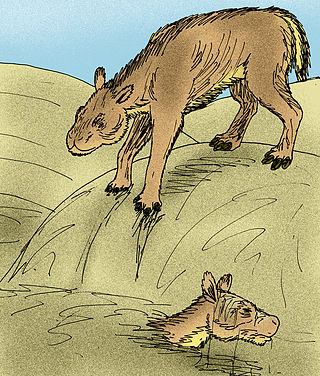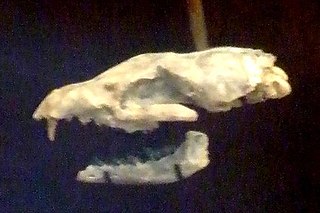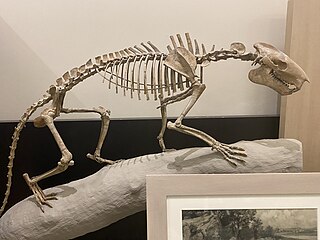
Artiodactyls are mammals belonging to the order Artiodactyla. Typically, they are ungulates which bear weight equally on two of their five toes: the third and fourth, often in the form of a hoof. The other three toes are either present, absent, vestigial, or pointing posteriorly. By contrast, most perissodactyls bear weight on an odd number of the five toes. Another difference between the two is that many artiodactyls digest plant cellulose in one or more stomach chambers rather than in their intestine as perissodactyls do. The advent of molecular biology, along with new fossil discoveries, found that cetaceans fall within this taxonomic branch, being most closely related to hippopotamuses. Some modern taxonomists thus apply the name Cetartiodactyla to this group, while others opt to include cetaceans within the existing name of Artiodactyla. Some researchers use "even-toed ungulates" to exclude cetaceans and only include terrestrial artiodactyls, making the term paraphyletic in nature.

Entelodontidae is an extinct family of pig-like artiodactyls which inhabited the Northern Hemisphere from the late Eocene to the Middle Miocene epochs, about 38-19 million years ago. Their large heads, low snouts, narrow gait, and proposed omnivorous diet inspires comparisons to suids and tayassuids (peccaries), and historically they have been considered closely related to these families purely on a morphological basis. However, studies which combine morphological and molecular (genetic) data on artiodactyls instead suggest that entelodonts are cetancodontamorphs, more closely related to hippos and cetaceans through their resemblance to Pakicetus, than to basal pigs like Kubanochoerus and other ungulates.

Merycoidodon is an extinct genus of herbivorous artiodactyl of the family Merycoidodontidae, more popularly known by the name Oreodon. It was endemic to North America during the Middle Eocene to Middle Miocene existing for approximately 30 million years.

The John Day Formation is a series of rock strata exposed in the Picture Gorge district of the John Day River basin and elsewhere in north-central Oregon in the United States. The Picture Gorge exposure lies east of the Blue Mountain uplift, which cuts southwest–northeast through the Horse Heaven mining district northeast of Madras. Aside from the Picture Gorge district, which defines the type, the formation is visible on the surface in two other areas: another exposure is in the Warm Springs district west of the uplift, between it and the Cascade Range, and the third is along the south side of the Ochoco Mountains. All three exposures, consisting mainly of tuffaceous sediments and pyroclastic rock rich in silica, lie unconformably between the older rocks of the Clarno Formation below and Columbia River basalts above.

Eporeodon is an extinct genus of oreodont belonging to the family Merycoidontidae. It lived from the Oligocene epoch 30.8—24.8 mya) existing for approximately 6 million years.

Miniochoerus is an extinct genus of small oreodont endemic to North America. They lived during the Late Eocene to Early Oligocene 38–30.8 mya, existing for approximately 7 million years. Fossils have been found only in North Dakota, South Dakota, Nebraska, Montana, and Wyoming.

Leptauchenia is an extinct goat-like genus of terrestrial herbivore belonging to the oreodont family Merycoidodontidae, and the type genus of the tribe Leptaucheniini. The genus was endemic to North America during the Late Oligocene to Early Miocene and lived for approximately 17.6 million years.

Leptaucheniinae was a taxon of small, goat-like oreodonts with proportionally big heads found throughout North America during the Late Oligocene. Because skeletons of Leptauchenia and Sespia have been found by the literal thousands, they are often quoted as being the most numerous fossil mammals in North America during the Late Oligocene. They had high-crowned, hypsodont teeth which were used to chew gritty vegetation.

Cormocyon is an extinct genus of borophagine canid native to North America. It lived from the Oligocene to the Early Miocene, 30.8—20.6 Mya, existing for about 10.2 million years. It is regarded as a primitive, transitional member of the Borophagini tribe.

The Daphoeninae are an extinct subfamily of dog-like, terrestrial carnivores, which belonged to the family Amphicyonidae of the suborder Caniformia. The group inhabited North America from the Middle Eocene subepoch to the Middle Miocene subepoch 42—15.97 million years ago (Mya), existing for about 26.03 million years.

Merychyus is an extinct genus of oreodont of the family Merycoidodontidae, endemic to North America. It lived during the Miocene, 20.4—10.3 mya, existing for approximately 10 million years. Fossils are widespread through the central and western United States.

Merycochoerus is an extinct genus of oreodont of the family Merycoidodontidae, endemic to North America. They lived during the Early Oligocene 33.9—30.8 mya, existing for approximately 3 million years. Fossils are widespread through the western United States.
Oreonetes is an extinct genus of oreodont endemic to North America from the Late Eocene 38.0—33.9 Ma living approximately 4.1 million years.

Merycoides is an extinct genus of oreodont of the subfamily Merycoidodontinae endemic to North America. It lived during the Oligocene to Late Miocene, 30.8—16.0 mya, existing for approximately 15 million years. Fossils have been uncovered throughout the western U.S. as well as Florida.
Paroreodon is an extinct genus of oreodont of the family Merycoidodontidae, subfamily Merycoidodontinae, endemic to North America during the Oligocene-Miocene subepochs, existing for approximately 10.2 million years.
Mediochoerus is an extinct genus of oreodont of the family Merycoidodontidae, subfamily Merycoidodontinae, endemic to North America during the Early Miocene-Middle Miocene subepochs, existing for approximately 7 million years.

Agriochoerus is an extinct genus of scansorial herbivore of the tylopod family Agriochoeridae, endemic to North America. Agriochoerus and other agriochoerids possessed claws, which is rare within Artiodactyla, as well as likely being scansorial. Agriochoerus was first described in 1869.
Ustatochoerus is an extinct genus of oreodont of the family Merycoidodontidae, endemic to North America. It lived during the late Oligocene to Miocene, 24–10.3 mya, existing for approximately 14 mya. Fossils are widespread through the central and western United States.

The Nimravinae are a subfamily of the Nimravidae, an extinct family of feliform mammalian carnivores sometimes known as false saber-toothed cats. They were endemic to North America, Europe, and Asia from the Middle Eocene through the Late Miocene epochs, spanning about 33.2 million years. Centered in North America, the radiation of the Nimravinae from the Eocene to Oligocene was the first radiation of cat-like carnivorans.

The Marsland Formation is a geologic formation in Nebraska. It preserves fossils dating back to the Neogene period.


















